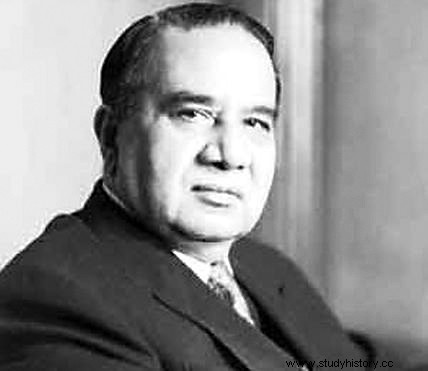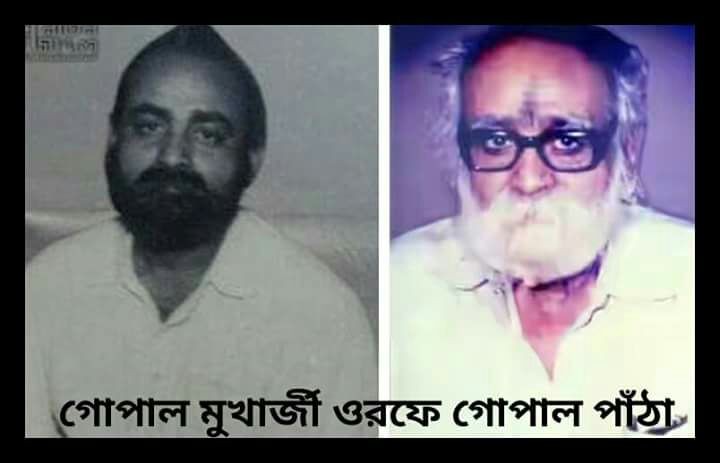Gopal Patha Khatik alias Gopalchandra Mukhopadhyay
To get the demand of Pakistan, the Muslim League had announced 'direct action' against the non-Muslims of India all over India. Kolkata, Noakhali and Rawalpindi were the most affected by the Muslim League's direct action against the Hindus. In Kolkata this incident is known as Kolkata murder and rape case. Jinnah had said that East Pakistan would be incomplete without Kolkata. Therefore, in direct action, the Hindu majority Kolkata was at the top of the agenda of the Muslim League. The Muslim League was the only government in Bengal. He declared a public holiday on 16 August 1946 and started massacre of Hindus under the leadership of Chief Minister Hussain Suhrawardy.
Bengal Chief Minister Hussain Suhrawardy instigated the massacre of Hindus

On 16 August Suhrawardy, while addressing a crowd of one lakh Muslims in the Ochterlony memorial complex, incited them to commit violence against Hindus, Buddhists, Sikhs and Jains and assured them that no police or army would interfere in their proceedings. At the instigation of Muslim League and the then Chief Minister of Bengal, Sohrabardi, Muslims started fierce riots in Calcutta and the border areas of Bengal and Bihar.
As soon as the Muslims left the crowd, they started looting, burning and violence shops and houses of Hindus, Buddhists, Sikhs and Jains. Maulvi from mosques, Maulana started inciting Muslims to crack down on Hindus. Within 72 hours more than twenty thousand Hindu people were killed, over thirty thousand were seriously injured and several lakh Hindus were rendered homeless. Thousands of innocent Hindu girls and women were gang-raped in front of their families and the Muslim League displayed its religious power by cutting them and their families. (Wikipedia)
On August 17, the situation became even more dire. The streets of Kolkata started looking like a cremation ground. All around, only the corpses of Hindus and vultures hovering over them were visible. When the Chief Minister of the state was behind the riots, then it was also meaningless to expect help from the state police. Suhrawardy himself was present at the police headquarters of Lalbagh and was stopping the police action against the rioters.

Communist leader Saeed Abdullah Farooqui, who was the president of the Garden Rich Textile Workers Union, gathered riot Muslims and attacked the Odia workers' slum in Lichhubagan. 600 Odia workers of Kesoram Cotton Mills were mercilessly slaughtered while those workers also showed them their card of being associated with Communist Party but political identity did not work in front of Jihad.
Veer warrior Gopal Patha alias Gopalchandra Mukhopadhyay (1913 – 2005)

Seeing the atrocities on Hindus, the blood of a young man named 'Gopal Patha' alias Gopalchandra Mukhopadhyay boiled. He, enraged by the killing of innocent Hindus by Muslims in Noakhali, Kolkata, Bengal, after the announcement of the massacre of Hindus by the Muslim League, along with some of his comrades, took up arms to eliminate the Muslim rioters. He gathered his companions, collected weapons and bombs and set out to teach a lesson to the rioters.
Gopal Patha Khatik alias Gopalchandra Mukhopadhyay's job was to sell and cut meat. His family worked as butchers in Boubazar, Kolkata, who moved to Kolkata in 1890 from Chowranga district of East Bengal. He was the nephew of revolutionary Anukulchandra Mukhopadhyay.
Shathet Shathyam Samacharet i.e. policy of tit-for-tat

Gopalchandra Mukhopadhyay was in favor of the policy of Shathet Shathyam Samacharet, that is, the policy of tit-for-tat. He formed an organization called Bhartiya Jatiya Vahini and asked his men to answer the rioting Muslims in their own language. He said if they kill one Hindu then you kill ten rioters. His companions started responding with knives, swords, sticks, rods and guns. Gopal Patha had two American 0.45 bore pistols of his own and also some grenades which he had bought from American soldiers posted in Kolkata after World War II with a similar suspicion which was in use today.
In an interview to the Indian Express in 1997, he said "It was a very critical time for the country. We thought if the whole area became Pakistan, there would be more torture and repression. So I called all my boys together and said it was time to retaliate. If you come to know that one killing has taken place, you kill 10 others. That was the order to my boys.”
Only 500 people of Gopal Patha against one lakh rioters
Against the one lakh Muslims of Hussain Suhrawardy, there were only around 500 men of his organization, but they were the people who wrestle in the arena every day. He fought the rioters with valor. Seeing his success, youths from Bihar, Uttar Pradesh and Odisha and Dalit youths of Bengal also joined him and started fighting the rioters. The Marwaris of Barabazar helped them all with money. Blacksmiths made knives, daggers and swords for them.
From August 18, under the leadership of Gopal Patha, Hindus started answering the rioting Muslims. First, the invading rioters who entered the Hindu area were caught and killed, then after entering the Muslim-dominated area, the rioters were dragged from their homes and killed. Members of the Muslim National Guards of the Muslim League were killed in large numbers but the Hindus did not touch the children and women.
Panic among Muslim rioters
Due to Gopal Patha, panic spread among Muslim rioters and when Hindus started getting heavy, Sohrawardy called the army and appealed to them for peace. He ended the rioters in such a way that Gandhi, who was silent on the killing of state sponsored Hindus, was so sad at the killing of Muslims that he came to Bengal and sat on a fast. He himself called Gopal twice, but Gopal flatly refused.
For the third time, a local Congress leader prayed to Gopal, "At least put some weapons in front of Gandhiji". Then Gopal said, "Where was your Gandhiji when Hindus were being killed? I have protected Hindu women of my area with these weapons, I will not lay down arms."
He said in his interview to Indian Express “Gandhi called me twice, I didn’t go. The third time, some local Congress leaders told me that I should at least deposit some of my arms. I went there. I saw people coming and depositing weapons which were of no use to anyone: out-of-order pistols, that sort of thing. Then Gandhi's secretary said to me:'Gopal, why don't you surrender your arms to Gandhiji?' I replied, `With these arms I saved the women of my area, I saved the people. I will not surrender them. Where was Gandhiji, I said, during the Great Calcutta Killing? Where was he then? Even if I've used a nail to kill someone, I won't surrender even that nail."
Theory of Balance of Power for Peace
Gopal Patha had maintained that organization till after independence. This is the reason that on the one hand, while Muslims had committed horrific massacres and rapes against Hindus, Buddhists, Sikhs in West Pakistan, Bengal remained almost silent in comparison because Gopal Patha had applied the principle of balance of power. The principle of balance of power is that, “War, riot or violence happens only when one side is weak. That's why balance of power is necessary for peace.
Today, when I remember that brave warrior Gopalchandra Mukhopadhyay, there is a lot in my heart. What has happened to Bengal today, the land of warriors, revolutionaries and sages! Now here instead of patriotic revolutionaries and mystics, Naxalites; Why are anti-India leftists and intelligent secularists starting to arise? After all what sin has happened from this holy land, which today such children are being born.
